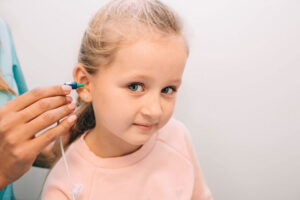By Eva Briggs, MD
 By age 18, one out of every five children in the United States will have some degree of hearing loss. Identification is vital. Decreased hearing impacts speech, language, education, social functioning, cognitive achievement and quality of life.
By age 18, one out of every five children in the United States will have some degree of hearing loss. Identification is vital. Decreased hearing impacts speech, language, education, social functioning, cognitive achievement and quality of life.
At birth, approximately one in 1,000 newborns has severe to profound hearing loss. Another one or two have lesser degrees of hearing loss.
Fortunately, current technology allows screening newborn infants for hearing loss in the nursery. If an infant fails the screening test, more detailed testing confirms or rules out hearing loss. One downfall is that some forms of hearing loss are not present at birth but develop in the first few months or later in childhood.
Here’s a quick refresher on the anatomy of the ear. Hearing starts with the outer ear, as sound travels down the ear canal to vibrate the ear drum. The eardrum transmits vibrations to tiny bones (ossicles) in the middle ear. The ossicles send the vibrations to the cochlea, the fluid-filled organ in the inner ear. Here the vibrations are converted to electrical impulses which are transmitted to the brain via the cochlear nerve. Hearing loss can be conductive (problems in the ear canal or middle ear obstructing sound wave vibrations), sensorineural (affecting the nerve), or a mixture of both types.
The most common causes of permanent congenital sensorineural hearing loss are: (1) congenital infection with cytomegalovirus (5-20%), (2) abnormalities of the temporal bones (30-40%), and (3) genetic causes (50%).
Cytomegalovirus (CMV) is a common virus that affects one in three children by age 5, and by age 40 about 50% of people. It usually causes no symptoms or a mild respiratory illness. If an infected mother passes the virus to an unborn baby, it can cause health problems including hearing loss.
Risk factors for early hearing loss include premature birth, low birth weight, jaundice, infections, prolonged mechanical ventilation and certain medicines.
Delayed hearing loss may be suspected when caregivers are concerned about a child’s hearing, speech or language. Many genetic causes of hearing loss have a delayed onset. CMV and other congenital infections (Zika virus, toxoplasmosis, rubella, herpes, syphilis) can cause delayed hearing loss. Other acquired causes of hearing loss are trauma, medications, and autoimmune disorders.
The Individuals with Disabilities Act (2004) provides free intervention services from birth to age 3 years for any child in United States identified with hearing loss. There is also a provision to provide educational assistance for children ages 3 to 21 through individual education plans and programs for hearing disability. Speech-language therapy and consideration of assistive devices should be started as soon as possible. The goal is to facilitate effective communication, and eventual academic success.
Most people are familiar with hearing aids. These devices are worn externally. A microphone detects sounds and feeds it to an amplifier to increase the signal reaching the inner ear. Children with severe to profound hearing loss may benefit from a cochlear implant. These surgical devices convert sound into electrical impulses transmitted directly to the cochlear nerve. They’re approved for children as young as 9 months. The internal portion has a receiver and stimulator. An external component worn around the ear has a speech processor, microphone, and transmitter. A third type of device, called a bone-conduction hearing aid may be either implanted or attached to the skin. This type of device bypasses the middle ear to transmit sound vibrations to the cochlear nerve.
What about sign language versus spoken language versus teaching both? Although there is controversy, many advocate for teaching all children with deafness sign language. Assistive devices aren’t perfect. But 96% of deaf children are born to hearing parents, most of whom don’t know sign language. I don’t know the answer, but believe that parents should make the decision in consultation with professionals with expertise in the field.
Eva Briggs is a medical doctor who works at two urgent care centers in the Syracuse region.

